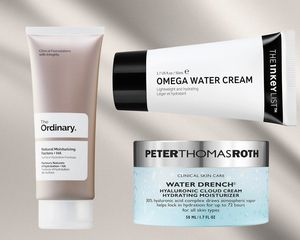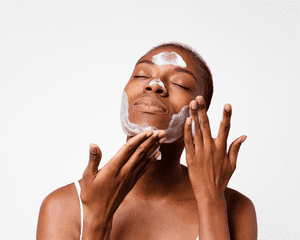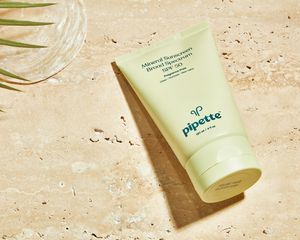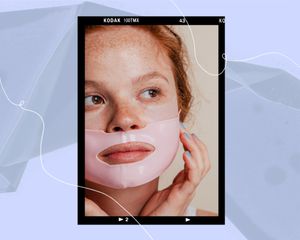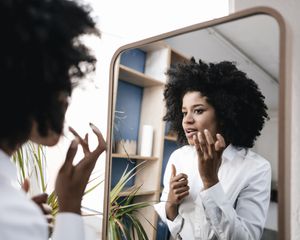:max_bytes(150000):strip_icc()/Stocksy_txp6055d20bLwa300_Medium_4414558-81fc219e142345019a57093c764e5d35.jpg)
Minette Hand / Stocksy
One thing’s for certain: Ingredients matter. The proof is in the growing number of beauty brands striving to be more transparent about their formulas. Believe it or not, there's a list of ingredients allowed in the U.S. that are strictly regulated or completely banned in other countries. Some of these ingredients are obviously detrimental to your health (like lead), while others seem more commonplace (like Selenium Sulfide, which is often used in dandruff shampoos). What exactly are these additives, and why are they deemed safe to use in the U.S.? We asked cosmetic chemist Ginger King and dermatologist Joshua Zeichner, MD, for their thoughts. Read on for nine ingredients that might be in your beauty products, but are restricted in other countries.
Meet the Expert
- Ginger King is a cosmetic chemist and the owner of product development firm Grace Kingdom Beauty.
- Dr. Joshua Zeichner, MD is a dermatologist, as well as the Director of Cosmetic and Clinical Research in Dermatology at the Mount Sinai Hospital in New York City.
Formaldehyde
Most commonly associated with the Brazilian blowouts, nail polishes, and nail hardeners, this ingredient is still being used in cosmetic products across the U.S. “It’s used to preserve dead bodies and has been found to be carcinogenic,” says King.
It’s banned in the EU not only for being a known carcinogen, but also for being associated with respiratory problems. The Cosmetic Ingredient Review found this ingredient safe to use in the U.S. under present practices and concentrations in nail products but ruled it unsafe in hair-smoothing products and treatments.
Hydroquinone
A possible carcinogen, this ingredient is banned in concentrations higher than 1% in the EU. It has most commonly led to photosensitivity, which means your skin is ultra-sensitive to the sun, among other skin conditions. Recently, it was banned for use in OTC products in the U.S., but you can still get it with a prescription.
Triclosan
This ingredient is banned in the EU for being an endocrine disrupter that can lead to a variety of health problems involving our hormones, including obesity and fertility issues. While triclosan is not banned in the U.S., the fact it's found in personal care products is controversial and the ingredient is under investigation in light of recent studies. Triclosan is used as an antibacterial, and is most commonly found in toothpaste, and soap. “It’s also used in hand sanitizer, but bacteria grows resistance to it, so it becomes ineffective," says King.
Lead
This ingredient is banned or regulated for cosmetic use in the EU, Canada, and Japan. Lead, a known neurotoxin, has been linked to reduced fertility in men and women, and it can still be harmful in small doses. While the dangers of lead seem obvious, it's been found in lipsticks in the U.S. from various brands. In fact, one study conducted by the Campaign for Safe Cosmetics that tested 33 popular lipstick brands showed that 61% of lipsticks contained lead. However, the FDA has ruled that the trace amounts found in lipstick are not enough to do any real harm.
“Lead is toxic,” says King, who notes it can be found in hair dye, in addition to lipstick.
Parabens
Parabens act as preservatives, preventing the growth of microbes, explains Dr. Zeichner. Five different parabens have been completely banned in the EU (isopropylparaben, isobutylparaben, phenylparaben, benzylparaben, and pentylparaben), while others are strictly regulated because they are believed to be endocrine disruptors. “This is based on lab research and animal data that don’t represent real world use of parabens in skincare products,” Dr. Zeichner says. “They are unlikely to cause any harm to our health when they are applied to the skin in skincare formulations. That being said, most of the new skin care products coming to the market are all paraben free so do you have the option to avoid them if you choose to.”
Here in the U.S., the FDA does not believe that parabens present a danger to our health when used in cosmetics. Parabens are commonly found in lotion, foundation, hair care products, shaving cream and more.
Key Takeaways
- Parabens are a common preservative found in many different beauty products.
- While the EU is much stricter with the inclusion of parabens in their beauty products, they're unlikely to cause harm when applied to the skin topically in skincare formulations, according to Dr. Zeichner.
Petroleum Distillates
Banned in the EU for being a possible carcinogen, this ingredient can be found in cosmetics in the U.S. “It’s a byproduct of gasoline that can have impurities and carcinogens associated with it,” says King.
This ingredient also goes by other names on ingredient lists, such as “paraffin wax.” The Cosmetic Ingredient Review found this ingredient to be safe in cosmetics with no adverse effects on user health. Petroleum distillates are most commonly found in mascara.
Phthalates
Another endocrine disrupter, phthalates can lead to a slew of hormonal health problems. Banned in the EU, this ingredient has been linked to developmental defects, fertility issues, and obesity. Despite these links, the FDA does not have evidence that phthalates present a safety risk when used in beauty products. Phthalates are often hidden in ingredient lists under the catch-all label “fragrance.” They are most commonly found in perfume, deodorant, and nail polish.
They’re less commonly used in skincare because of the risks associated with them, says Dr. Zeichner. “Phthalates are compounds commonly used in plastics to make them bendable and in skincare products two improve their aesthetics and consistency,” he says. “ It is unclear whether using skin care products containing phthalates are truly associated with harm to our health.”
Selenium Sulfide
This ingredient has been banned in the EU and Japan because of concerns regarding toxicity and harmfulness for consumers and the environment. According to a report by the National Toxicology Program, it’s “reasonably anticipated to be a human carcinogen.” This conclusion was reached after lab tests on mice showed the growth of tumors after oral exposure. However, the FDA has not found selenium sulfide to be dangerous in small amounts, and approves of its use at 1% concentration in dandruff shampoo. It's most commonly found in anti-dandruff shampoo.
Quaternium-15
"It's a formaldehyde donor, meaning, when this ingredient is exposed to high temperature, it can turn formaldehyde, which is not desirable," says King. Banned in the EU for being a possible carcinogen, it is also a common allergen. However, the CIR has found quaternium-15 to be safe for use in cosmetics in concentrations up to 0.2%. In the U.S., it's most commonly found in eyeshadow, shampoo, and body wash.

